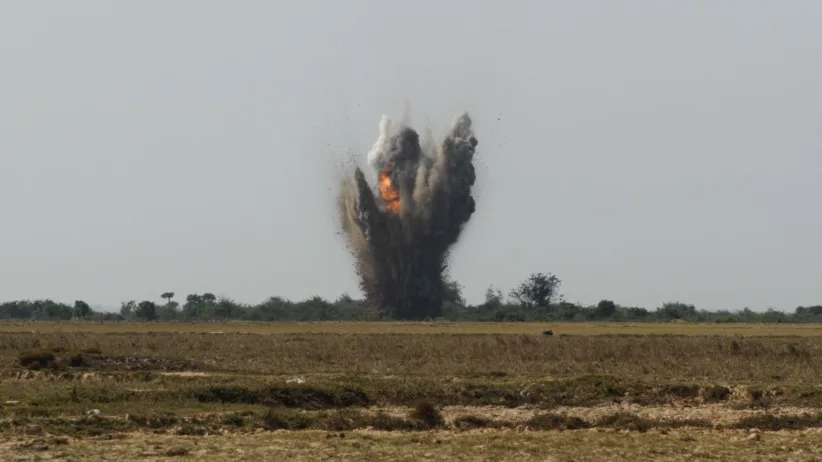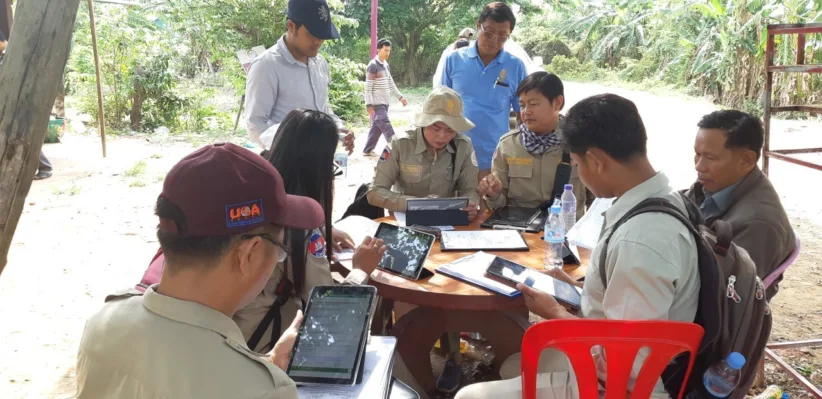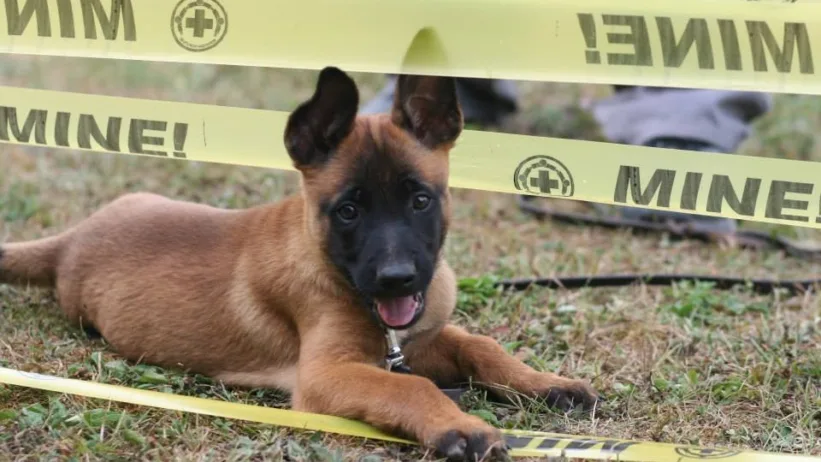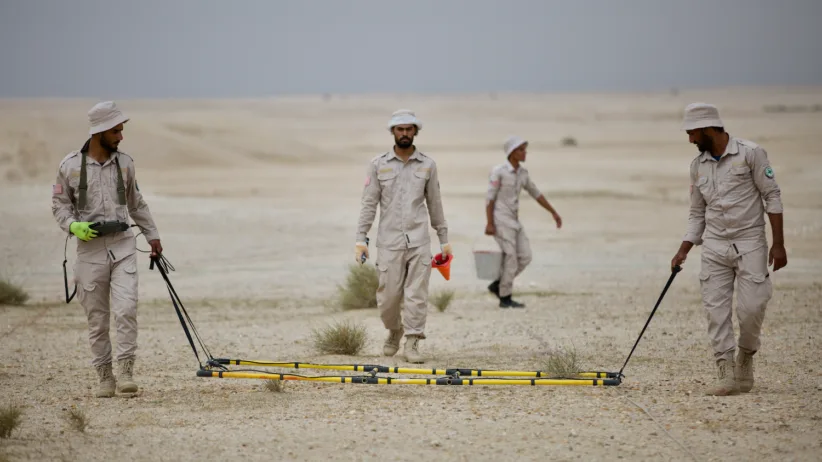NPA clears landmines, cluster munitions and explosives left after war and conflict. Since the first mine clearance operations startet up in Cambodia in 1992, we have cleared one billion square metres of land and removed over 2 million landmines and explosives in 45 countries.
Application and promotion of good land release methodology is core to NPA’s Mine Action work. This involves the application of all reasonable effort to identify tight confirmed hazardous areas using an evidence-based approach comprising of non-technical survey, technical survey, and clearance. Suspected hazardous areas are considered as areas where further survey is needed.
The first phase in Land Release is the Non-Technical Survey (NTS), whereby new and already existing information about areas suspected of having mines or unexploded ordnance is collected and analysed. Such areas are known as Suspected Hazardous Areas (SHA).
It is often possible to delete parts of an SHA and release them for use solely on the basis of the collected information that shows that the area is not, in fact, affected. Such a release thus happens without the use of any clearance resources.
An area confirmed as dangerous on the basis of the analysis, is termed a Confirmed Hazardous Area (CHA). A demarcation line (polygon) is then drawn up around it. Non-technical survey can sometimes define fairly accurate CHA polygons. At other times, non-technical survey must be reinforced with elements of technical survey for improved accuracy.
The next phase is the Technical Survey. Personnel then use different tools such as dogs, machines or manual deminers to look for information in the hazardous areas. Personnel look for mines, explosives, possible patterns, other signs of warfare and tactical reasons for laying mines, collecting and analysing information, which indicates where the mined area is located.
Personnel can then further determine the area enclosed by the polygon and cancel the areas that fall outside. The Technical Survey also helps determine what types of clearance resources are most suitable for a given area. Once technical survey has been carried out, personnel draw up detailed clearance plans.
With the Land Release concept, the actual clearance becomes the final phase and the last method to be taken into use. Wherever possible, NPA personnel do not commit clearance resources to an area before they have actually concluded there are explosive hazards on the ground.
Cluster Munition Remnants Survey (CMRS)
To effectively address cluster munition remnants, NPA has developed an evidence-based survey system that takes into account the unique characteristics of Cluster Munition Remnants contamination in many parts of the world. The methodology, known as Cluster Munition Remnant Survey (CMRS), has proven highly efficient and effective in defining accurate Confirmed Hazardous Areas (CHAs).
Five main activities apply when setting out to identify and release areas containing cluster munition remnants in any given context: desk assessment, non-technical survey, impact assessment, technical survey, and clearance. Contaminated areas are identified and subsequently released following combinations of these activities.
The first phase of the CMRS is the desk assessment. The purpose is to assess and identify areas that may be contaminated with cluster munition remnants. A desk assessment involves study of historical records, including bombing data when available, victim data and other central sources of information.
An essential component of the desk assessment is to develop an appropriate information management system and methods of assessing information. The desk assessment will normally reveal potentially contaminated areas where evidence based-survey is needed.
Non-technical survey is a semi-intrusive, on-the ground activity conducted to verify information from the desk assessment. Well-trained survey teams study and analyse data from the desk assessment prior to gathering information from informants and visiting suspected sites.
The survey focuses particularly on visible evidence of cluster munition remnants (evidence points), bomb casings, and other evidence that may help establish the contaminated area. Non-technical survey staff will, when appropriate, walk randomly into suspected areas to look for evidence of cluster munition remnants.
The non-technical survey is sometimes combined with an impact assessment whose purpose is to identify socio-economic impact from cluster munition remnants and guide prioritisation of follow-on technical survey and clearance. Non-technical survey can sometimes define fairly accurate Confirmed Hazardous Area (CHA) polygons (affected areas). At other times, non-technical survey must be reinforced with elements of technical survey for improved accuracy of the CHA polygons
In the technical survey phase, clearance assets are used in an information gathering context where the aim is to learn about the strike and the footprint, as opposed to ensuring the removal of all cluster munition remnants. The key to efficient technical survey is to focus more on when no evidence of cluster munition remnants is found after a reasonable survey effort, and to cancel these areas.
In summary, the output from technical survey is either to reinforce non-technical survey for the purpose of defining accurate CHA polygons, or to disconfirm any suspicion of cluster munition contamination.
Clearance becomes the final phase and the last method to be taken into use. Personnel do not commit clearance resources to an area before they have actually concluded there is confirmed cluster munition contamination, before personnel know how large the polygon is, which resources personnel wish to use, and where and when they should be deployed.
Explosive Ordnance Disposal (EOD)

In addition to performing survey and clearance, NPA undertake Explosive Ordnance Disposal (EOD). EOD personnel operate separately or within survey and clearance teams. They are specialised to identify and carefully evaluate all mines and unexploded ordnance found, in order to establish the safest method of handling or disposal. They then destroy objects in site or disarm before removing them to a collection point for detonation later.
EOD personnel must be able to distinguish between a large number of objects that all look identical to the untrained eye, but which in fact may be classified as anything from safe for removal to extremely unstable. EOD personnel also deal with all types of unused explosive munitions abandoned or dumped by armed forces when leaving an area. This may concern anything from a few individual objects to entire arms dumps.
Battle Area Clearance is a systematic and controlled search for and disposal of explosive remnants of war in a former battle area. Battle Area is a part of suspected hazardous area for which the following information has been confirmed:
- Presence of fired or dropped unexploded ordnance;
- Presence of unexploded ordnance that has been armed/prepared for firing/dropping but has not been fired/dropped;
- Presence of unexploded ordnance that has not been armed/prepared for firing/dropping; for example ordnance in temporary munitions storages, which is, however, not part of national stocks;
- Absence of minefields.
Battle areas requiring area clearance on the surface or at shallow depths are rare, and spot tasks are sufficient to destroy individual pieces of ordnance.
Abandoned explosive ordnance (AXO) means explosive ordnance that has not been used during an armed conflict, that has been left behind or dumped by a party to an armed conflict, and which is no longer under control of the party that left it behind or dumped it. Abandoned explosive ordnance may or may not have been primed, fused, armed or otherwise prepared for use.
Capacity Development

Landmines, cluster munition remnants and other explosive ordnance (EO) pose a serious and ongoing threat to civilian lives, deny access to resources and hinder development. Reducing their impact requires long-term solutions and the development of competent, accountable and transparent national institutions. However, many internal and external factors – including low levels of state financial contributions, inadequate training and lack of expertise – impede the capacity of states to respond to EO contamination.
Mine Action is a national responsibility. The conventions that provide the international framework for mine action require states to demonstrate high levels of national ownership. A better-regulated and coordinated national mine action programme ensures efficient planning, tasking, implementation and reporting of mine action operations.
NPA defines Capacity Development of the National Mine Action Authorities (NMAAs) and local Implementing Partners (IP’s) as
the process of establishing, strengthen and maintaining national capacity at the enabling environment, organizational, and individual levels to support the NMAAs and local IP’s to manage and implement mine action programmes safely and efficiently
NPA implements its capacity development project guided by the following principles:
- National ownership: Ultimate responsibility rests with the NMAA. NPA Advisors support the NMAA in a process to implement their Mine Action Programmes
- Coordination: Capacity Development plans and activities are well coordinated with all mine action stakeholders in country
- Adaptation to local conditions: Advisors ensure that the proposed response and solutions conform with local laws and socio-political norms
- Partnership: NPA promote a culture of partnership and networking with other international stakeholders (GICHD, JMU, UNDP, UNMAS) and other INGOs
- Quality: NPA advisors deliver activities that are or quality and in compliance with international standards, setting the standard for the NMAA to conform to IMAS requirements
- Shared responsibility: NMAAs and/or IPs share equal responsibility and accountability with NPA.



